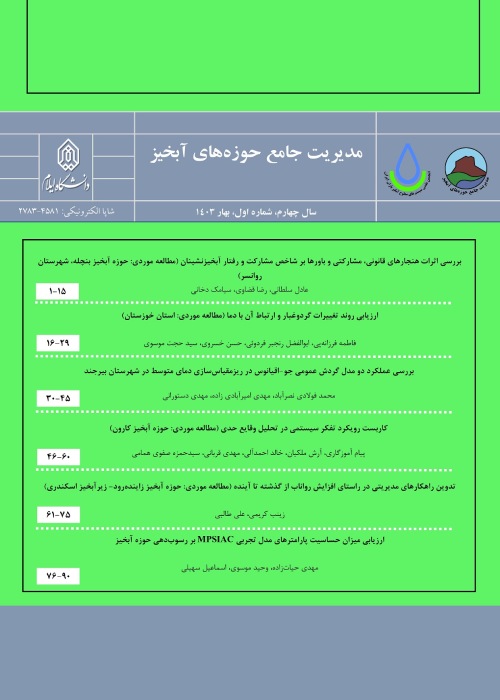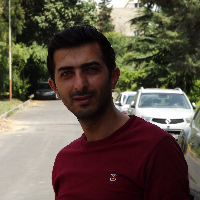Erosion Hazard classification using the Fargas qualitative model in the Chehelgazi Sub-Watershed of Kurdistan province
Today, soil erosion has become one of the biggest problems in the world, especially in arid and semi-arid areas, which affects environmental, agricultural and food security issues. On the other hand, the growth and development of human activities along with land use change and resource destruction are among the factors affecting the intensity of erosion. Soil erosion in Iran has intensified due to the destruction of natural resources in recent years, and land use changes have played a significant role in this process. However, until now, preventive approaches based on soil erosion hazard assessment to adopt correct management measures have received less attention, which is mostly due to the lack of necessary statistics and information in the basins. Therefore, in any case, it is necessary to identify the areas prone to erosion and sediment production in the internal sub-basins of Iran, which lead to the loss of thousands of tons of fertile soil every year. To achieve this objective, models have been presented, each of which has strengths and weaknesses. By organizing the information related to the decision-making process and simulating the factors affecting the decision, as well as by simplifying the relationships in nature, the models lead to the understanding natural systems. Models are tools that are used in combination with many other assessment methods, so it can be said that modeling is the best option for the initial assessment of watersheds without statistics or with limited statistics. Therefore, the present study was conducted with the aim of investigating the hazard and identifying the areas sensitivity to soil erosion in the sub-basin of the Chehelgazi watershed of Kurdistan province using the Fargas model.
Chehelgazi sub-basin as one of the sub-basins of Qeshlaq dam is located in Sanandaj province. Considering the natural and weather conditions, it is considered representative of mountainous areas (27,233 hectares and equipped with a hydrometric station). The average height of the mentioned sub-basin is about 2200 meters above the sea level, and also the average annual rainfall in this sub-basin is 294.2 mm, the area of pastures is 23465 and the total of irrigated and rainfed agriculture is 3768 hectares. Fagas model was used in order to investigate the hazard and identify the areas sensitive to soil erosion in the mentioned sub-basin. In determining the hazard of erosion, the Fargas model considers two factors of erodibility of rocks and drainage density in each rock unit. In this research, by using maps of rock units, drainage density and scoring tables related to the model, a soil erosion hazard map of the basin was prepared. In the first step, the rock units of the basin were determined using the geological map, and based on the model guide, the rock resistance to erosion was evaluated. In the second step, the drainage network map of the studied basin was prepared and integrated with the stone unit map, and after integration, the drainage density of each stone unit was determined and based on the model valuation guide, the drainage density of each stone unit was valued. Finally, the erodibility hazard map of the basin was prepared in five categories (low to very severe) by multiplying the value number of rock erosion resistance and drainage density in each rock unit.
The results of the Fargas model analysis showed that 0.48, 36.15, 15.35 and 48% of the sub-basin are in low, medium, severe and very severe erosion hazard, respectively. In other words, 63.35% of the sub-basin is in a state of severe and very severe erosion hazard. Comparing the results of the model with various studies in the basin and other similar basins showed that the Fargas model estimates the erosion hazard more than the actual value, which can be caused by the valuation of rock units. However, the existence of shale and its high sensitivity to erosion in the basin and the confirmation of the model in determining its erosion hazard can be a confirmation of the efficiency of the model.
The results of the present study indicate the hazard of high erodibility of the sub-basin. Because of the the sub-basin's position in the water supply of Qeshlaq Dam, it is suggested, while examining other quantitative and qualitative models and their results, to provide evaluation and planning models, to make management decisions, and to promote, train, and implement useful projects related to reducing the rate of displacement and loss of the soil at the basin level. Because in order to increase the life and efficiency of dams, the entry of sediment into the dam should be as low as possible to be a small step towards reducing the rate of soil erosion and wastage. However, according to the results of the model, it can be observed that the studied area is under severe hazard of soil erosion, and these results are useful for researchers and planners to control erosion; but due to the limited number of studies in the region, other studies should be conducted in the region for more certainty.
- حق عضویت دریافتی صرف حمایت از نشریات عضو و نگهداری، تکمیل و توسعه مگیران میشود.
- پرداخت حق اشتراک و دانلود مقالات اجازه بازنشر آن در سایر رسانههای چاپی و دیجیتال را به کاربر نمیدهد.




